Reserve Bank of Australia Annual Report – 1997 Customer Services
The Bank is engaged in providing a range of commercial services to customers. They involve banking services to the Commonwealth Government and other customers; a registry of Commonwealth Government and other securities; electronic transfer and settlement of securities; and a specialised currency distribution service for banks. (Note printing, a separate commercial activity by Note Printing Australia, is discussed on pages 60 to 62).
Of these activities, current arrangements for handling the Commonwealth Government's cash balances are central to the conduct of the Bank's domestic market operations. The other commercial activities are not ‘core’ functions of a central bank, which are generally limited to monetary policy, financial system surveillance and currency note issue. Nonetheless, the Bank has developed substantial expertise in these activities and they provide valuable synergies with the Bank's broader policy roles. The Bank's involvement in transactional banking, for example, has enabled it to give impetus to payments system reform in Australia and will assist in the smooth functioning of the new real-time gross settlement (RTGS) system. The activities are all run as discrete businesses which seek to recover their full costs, and earn a return on notional capital, through fees and charges.
In 1996/97, revenues from commercial activities were $40.7 million compared with costs of $36.3 million. The latter includes direct and indirect costs, commercially based rents and fully allocated overheads in line with competitive neutrality principles. Revenues and costs for specific commercial activities are set out below.
During the year, the Bank's commercial activities were reviewed by the Competitive Neutrality Taskforce, established by the Commonwealth Government to implement competitive neutrality principles in all government business enterprises. The Bank was able to demonstrate that it has a clear accounting separation between its commercial and other activities and that competitive neutrality standards are being met.
In addition to its commercial activities, the Bank is responsible for the design, issue and integrity of Australia's currency notes. This is a core function of the Bank and, with limited exception, is provided to the community free of charge.
Strong competitive pressures, technological change and the pursuit of a sharper commercial focus lay behind a reorganisation of the Bank's Business Services Group in 1996/97 along business unit lines, rather than the traditional departmental/branch structure. Activities are now divided into two major streams:
- Banking and Settlement Services – comprising government banking, registry and settlement operations; and
- Note Issue – comprising currency research, currency operations and gold activities (the latter are discussed in ‘Operations in Financial Markets’).
The reorganisation has resulted in significant staff reductions, which are being addressed under a redundancy program, and in the decision to close the Bank's Darwin branch because of insufficient business volumes.
Banking and Settlement Services
Government banking
The Bank manages the Commonwealth Public Account through which major flows to and from the Commonwealth Government pass. In addition, it provides transactional banking services to a small range of customers through its network of capital city branches. Along with the Commonwealth Government and its departments, these include several State Governments and government instrumentalities, and a number of overseas official institutions. To meet their specific needs, the Bank has developed specialised banking systems in partnership with its customers; these systems interface with customers' own systems to ensure efficient and cost-effective services on a ‘whole of government’ basis. Where appropriate, the Bank also draws on third-party suppliers such as international banks and Australia Post to augment the services it provides.
The volume of customer business continues to grow. In 1996/97, electronic transactions processed through the Bank's Government Direct Entry System (GDES) rose by 2.9 per cent, to 214 million. This system has now been extended to enable the Commonwealth Government to make overseas payments electronically, making use of the global banking network of Citibank NA.
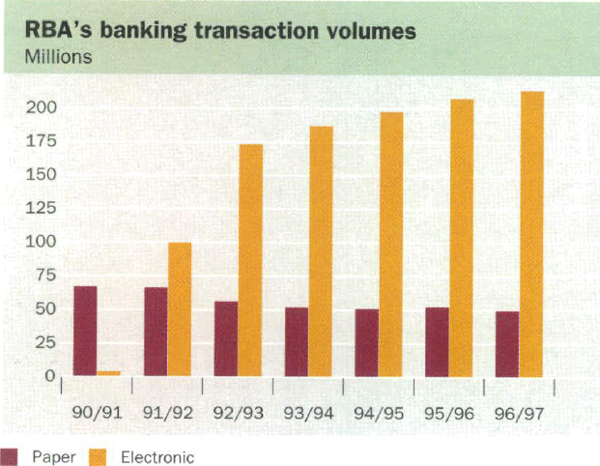
The Bank's financial electronic data interchange (EDI) facility processed just over 121,000 transactions in 1996/97, 16 per cent more than the previous year. The Department of Finance is the major user, making interagency payments and disbursements from the Commonwealth to the States. The Commonwealth Government's commitment to settling a wider range of commercial transactions electronically will provide impetus to the spread of this type of facility among financial institutions.
The number of customers using Reserve Link, the Bank's PC-based banking package, grew from 195 to 278 during 1996/97. The growth was mainly due to the devolution of responsibility for day-to-day banking operations from State Treasuries to individual budget agencies.
In contrast to the growth in electronic banking, paper-based transactions processed by the Bank fell in 1996/97 from 53 million to 50 million, resuming the downward trend of recent years. Such transactions, nonetheless, remain important to the banking needs of some government agencies, particularly those receiving low-value, high-volume payments from the general public, many of whom wish to make payments in person. To expedite such transactions, the Bank has engaged Australia Post as an agent to provide a payment service for government bills – extending existing arrangements for tax payments – as well as a deposit-taking and cheque-encashment facility for government agencies.
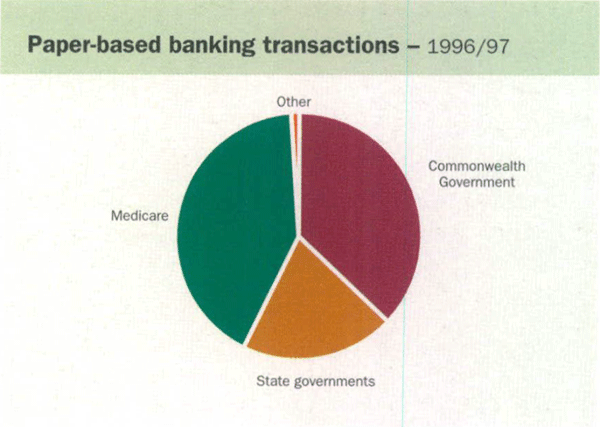
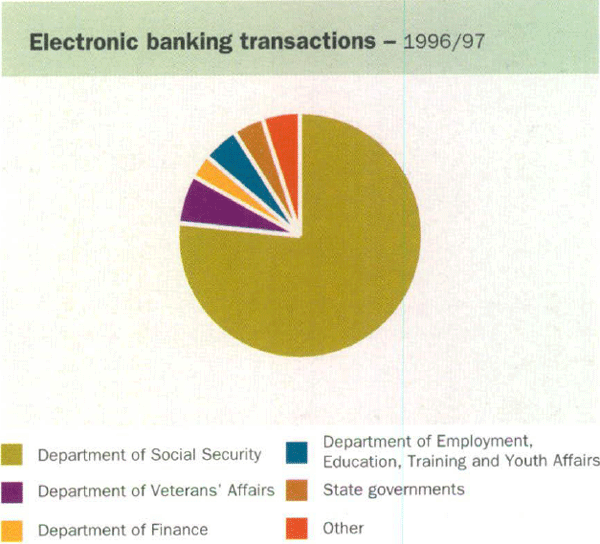
Also in response to customer demand, the Bank has introduced a cheque printing and mailing service using the facilities of EDI POST, an Australia Post service. Under these arrangements, customers' payment instructions are delivered electronically to the Bank each day, aggregated and sent via electronic file to EDI POST for cheque production and mailing.
The scope for outsourcing the processing of cheques is currently being reviewed. The sorting and clearing of cheques is subject to significant economies of scale which the Bank, being a relatively small player, is unable to exploit. As the shift from paper-based to electronic transactions gathers pace, a more general industry rationalisation of the cheque processing business seems inevitable.
During 1996/97, the South Australian Government reconfirmed its longstanding banking relationship with the Bank after reviewing its banking needs and service delivery options. Under new arrangements the Bank has assumed the role of prime contractor for that Government's banking services. Where it can provide these services competitively as a sole provider, it will do so; where it does not offer the services required – e.g. purchase cards – or where third-party suppliers are more competitive, the Bank will select a provider through a tender process and manage the outsourcing relationship.
The Bank also acts as adviser to the Commonwealth Government and its agencies on payments and collections systems. The aim is to encourage ‘best practice’ electronic processing and cash management arrangements by the Commonwealth, irrespective of whether banking services are provided directly by the Bank or through third-party suppliers. In this context, the Bank assisted the Department of Finance during 1996/97 with the further improvement of cash management arrangements. In a similar vein, the recent initiatives with Australia Post have resulted in a speedier flow of payments to the Commonwealth.
| Total revenues | 23.8 |
|---|---|
| Total costs | 21.0 |
| Net earnings | 2.8 |
Paper Versus Electronic Payments
The impact on the economy of advances in communications and information technology has been profound. The substantial productivity gains available are nowhere better exemplified than in the case of electronic direct entry, which is taking over from traditional paper-based systems. Payment by paper-based means is costly, labour intensive, requires significant capital investment and often results in delays in the receipt of payments.
This can be illustrated by comparing the number of steps involved in a payment made by cheque with the same payment made by direct entry. The example below shows social security payments made by the Bank to pensioners on behalf of the Department of Social Security (DSS). The first step in both cases is for the Department to construct the list of recipients and the amounts to which they are entitled. The Bank is only involved in the actual payments (and the interbank transactions which underlie these).
| Payments made by cheque | Payments made by direct entry |
|---|---|
| 1. List of recipients established by DSS | 1. List of recipients established by DSS |
| 2. Cheques prepared | 2. File containing recipients' account details and amount of entitlement sent to RBA |
| 3. Cheques posted to private addresses | 3. RBA sorts and sends payment file electronically to individual financial institutions. RBA credits accounts of financial institutions and debits DSS's account. |
| 4. Recipients take cheque to their financial institution | 4. Financial institutions credit recipients' accounts |
| 5. Funds credited to recipients' accounts | |
| 6. Cheque returned to RBA so that recipients' financial institution can be credited and DSS's account debited | |
| 7. Details of cheques paid returned to DSS for reconciliation against cheques issued | |
| 8. Cheques stored for up to seven years |
Not only is direct entry much more efficient and cheaper to provide, it is clearly a better product for the consumer. Unlike payments by cheque, funds received electronically are immediately available. Electronic payment is also more reliable, does not require the recipient to take a trip to their bank and makes fewer demands on transport, postal systems, etc.
Registry services
The Bank provides registry services for the Commonwealth Government, borrowing authorities of the governments of South Australia and Western Australia, and several other local and foreign official institutions. Services are provided through the Bank's branches and include issuance of securities, maintenance of ownership records, payment of interest and redemption of securities at maturity.
Registry activities fell slightly in 1996/97. This mirrored the experience of debt registry business generally, one that is a declining area of the financial services industry and subject to strong competitive pressures. Rapid advances in electronic data processing and communications offer substantial economies of scale; at the same time, however, registry volumes are declining as issuers contract in number and have greater recourse to cheaper and more flexible funding available in wholesale markets.
| Total revenues | 4.1 |
|---|---|
| Total costs | 2.9 |
| Net earnings | 1.2 |
Settlement services
The centrepiece of the Bank's settlement services is the Reserve Bank Information and Transfer System (RITS), which allows members to settle electronically their transactions in Commonwealth Government securities. Some 222 organisations are represented on the system, much the same as a year earlier. RITS handles over 98 per cent of turnover in the professional market, and has $97 billion of securities lodged in it.

Other services provided by RITS include electronic tendering for Treasury bonds, notes and adjustable rate bonds; the automatic payment of interest and maturity proceeds in respect of securities held in the system; provision for members to use securities in RITS to secure loans and to settle reciprocal purchase transactions; a capacity to make high-value payments; and a facility for simultaneous settlement of interbank obligations arising from the settlement of equity transactions on CHESS, the Australian Stock Exchange's electronic settlement facility. The excellence of RITS has again been confirmed in the 1996 international survey of global custodians by Global Securities Consulting Services (a UK company), which ranked Australia number one in fixed-interest securities settlement for the third year in succession.

As noted already, RITS has been substantially upgraded to provide the basis of the new RTGS system for high-value interbank payments. The Bank is also intending to develop reciprocal arrangements with the Central Moneymarkets Unit, the securities settlement system of the Hong Kong Monetary Authority.
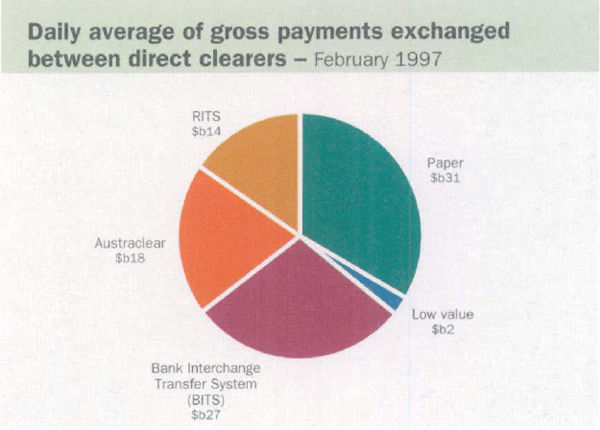
In the interbank settlement process, the Bank acts as collator for the Australian Payments Clearing Association (APCA). Each day, the Bank collates details of each bank's obligations arising from transactions in the various clearing systems and calculates the net amount owed to or by each bank for settlement to Exchange Settlement Accounts on RITS at 9.00 am the next morning. Gross settlement flows average a little over $90 billion per day, of which $59 billion come from high-value electronic systems, $31 billion from paper clearing (mainly cheques) and around $2 billion from low-value electronic systems. To improve the efficiency and security of the interbank settlement process, the Bank is planning to introduce an automated facility for banks to communicate with the collator, replacing the existing fax-based system.
The Bank also has settlement responsibilities arising from its own activities in the foreign exchange and domestic securities markets, and from the activities of the Commonwealth Government and overseas official institutions. These high-value transactions currently take place across RITS and Austraclear's system and some will take place across the SWIFT message service when it becomes available with RTGS. Like others, the Bank has been reassessing its SWIFT connections in anticipation of RTGS and has further automated its SWIFT-related activities.
| Total revenues | 4.9 |
|---|---|
| Total costs | 2.1 |
| Net earnings | 2.8 |
Note Issue
The Bank's note issue activities cover research into and development of note designs and security features; storage and issue of new and reissuable notes; and the processing of notes returned from circulation for quality control purposes. In addition, the Bank currently provides a specialised cash distribution service to banks.
Research and development
Following the introduction of a full series of polymer-based notes in Australia, the Bank's current research efforts are directed at enhancing the security of currency notes against counterfeiting. These efforts are shared with Note Printing Australia and with Securency Pty Ltd, a joint venture company established with the Belgium-based manufacturer, UCB Films PLC, to market polymer substrate internationally.
Australia's polymer notes incorporate a range of security features which have helped to reduce the rate of counterfeiting, particularly ‘casual’ counterfeiting involving use of a colour photocopier. However, polymer notes cannot eliminate counterfeiting altogether. The Bank's research program gives priority to the development of new security features which can be used only with polymer notes.
The Bank also continues to seek improvements in the durability and handling characteristics of polymer.
Benefits of polymer
Experience to date with the new note series has revealed that:
- polymer notes last around four times as long as their paper counterparts, cutting the Bank's new note requirements to around 150 million pieces a year or about one quarter of the requirements for paper notes;
- their improved durability and security mean that the Bank does not need to examine polymer notes for fitness and authenticity as frequently as paper notes. Steps are under way to reduce the level of note processing carried out by the Bank by around 30 per cent, with substantial cost savings;
- the added cleanliness of polymer notes has increased the efficiency of, and reduced the maintenance requirements for, machine processing of notes, such as in ATMs; and
- the production of polymer substrate is significantly more energy-efficient and less polluting than the production of specialised banknote paper. Polymer notes no longer fit for circulation are granulated and the residue is recycled, whereas paper notes were disposed of either by burning or through landfill.
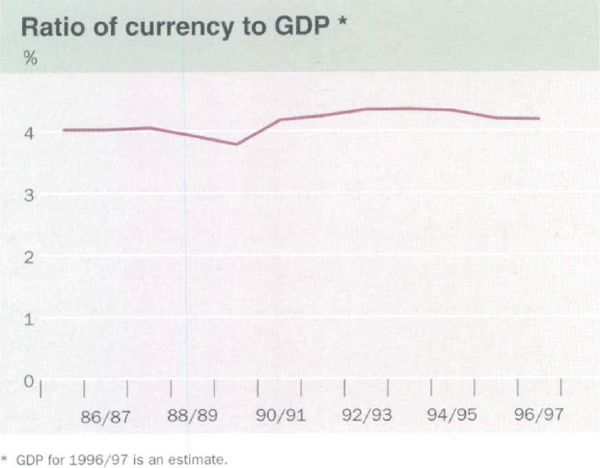
Currency operations
Notwithstanding the strong growth in electronic payments mechanisms such as EFTPOS and direct entry, the public's demand for currency notes continues to grow broadly in line with the economy. In 1996/97, the value of notes on issue rose by 4.6 per cent, faster than in the previous year. The high denomination $50 and $100 notes continue to account for about 85 per cent of the value of notes on issue, the $50 note now absorbing the largest share in response partly to the needs of ATMs. The vast majority of notes in circulation is now polymer-based.
The Bank issued into circulation around $68 billion in notes during 1996/97 and had around $67 billion in notes returned. Nearly half of these flows went through a specialised note-bag distribution service to banks' branches, for which a full charge has been made from 30 September 1996. The remaining flows were on a bulk or wholesale basis and attract only a nominal charge.
| At end June | $1 | $2 | $5 | $10 | $20 | $50 | $100 | Total | Increase (per cent) |
|---|---|---|---|---|---|---|---|---|---|
| 1992 | 42 | 71 | 261 | 585 | 1,836 | 5,724 | 6,660 | 15,180 | 2.6 |
| 1993 | 42 | 70 | 297 | 591 | 1,813 | 6,284 | 7,269 | 16,367 | 7.8 |
| 1994 | 21 | 69 | 313 | 634 | 1,795 | 6,837 | 7,907 | 17,577 | 7.4 |
| 1995 | 20 | 49 | 332 | 614 | 1,848 | 7,193 | 8,482 | 18,538 | 5.5 |
| 1996 | 19 | 48 | 337 | 583 | 1,868 | 7,928 | 8,399 | 19,182 | 3.5 |
| 1997 | 19 | 47 | 351 | 601 | 1,837 | 8,912 | 8,297 | 20,064 | 4.6 |
The note-bag service is not a core activity for the Bank and its competitive outlook is poor. It has also tended to inhibit the development of more efficient currency distribution methods. Gross flows to and from the Bank are excessive and not well co-ordinated with the public's specific needs, resulting in higher transportation, insurance and processing costs and greater security risks. As a consequence, the Bank has informed banks that it intends to cease the note-bag service around the middle of 1998. Some staff redundancies at the Bank will be involved.
| Total revenues | 4.2 |
|---|---|
| Total costs | 4.6 |
| Net earnings | −0.4 |
During 1996/97, the Bank processed 1.4 billion used notes through its high-speed note processing machines, which were enhanced by the installation of fitness detectors developed especially for polymer technology. Of the total, about 87 per cent were passed fit for reissue, a percentage which has been growing in recent years because of the durability and cleanliness of polymer notes. Experience confirms that polymer notes can be processed more efficiently than paper notes; the reduction in the cost of processing each 1,000 notes from $9.40 when paper notes were in circulation to $7.90 currently, reflects in part the switch to polymer.